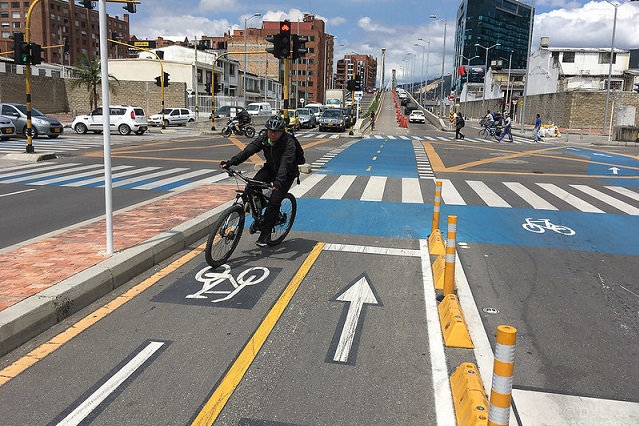
The grave consequences of road traffic crashes are not a common theme in election campaigns. Nevertheless, the legislatures of Chile, Mexico and Colombia have recently advanced or are in the midst of debating valuable legislation to reduce traffic deaths and severe injuries resulting from road crashes. In all three countries, activists from civil society organizations and academia have played a significant role in moving such policies forward. In 2018, Chile’s Parliament adjusted the Road Convivence Law, establishing a 50 kph (30 mph) speed limit for urban areas. This is common in most member countries of the OECD, but not in most middle- and low-income countries. The 50 kph speed limit is in line with recommendations by the World Health Organization and a cornerstone of the UN Decade of Action for Road Safety initiative, which aims for a 50% reduction in traffic fatalities between 2021 and 2030.
Currently, the Chilean government is asking parliament to approve the Automatic Control Center for Traffic Violations, Ley CATI. This would establish a central authority to implement and manage speed cameras and radars to enforce speed limits and shift driver behavior. In both cases – the 2018 law and this proposed legislation – there has been strong advocacy by multiple organizations promoting road safety and sustainable mobility, notably the Movimiento Contra el Exceso de Velocidad Letal and the Bicicultura movements. These groups were the backbone of a large coalition of mobility and health activists who were instrumental in persuading key congress members to become champions of these legislations. As of April 2022, the Ley CATI received urgency status by the new Chilean government to fast-track its approval in parliament.
In Mexico, the Congress approved a constitutional amendment in 2019 to establish safe mobility as a fundamental right and critical to equity and accessibility for all. Twenty three out of the 30 Mexican states have ratified the amendment. To put this new amendment into effect, the Senate passed the Safe Mobility Law, the first national legislation to advance road safety, which was previously a matter handled by the states (see the published law here). Like in Chile, a wide citizens’ movement advocated for these changes under the Coalición Movilidad Segura (“the Safe Mobility Coalition”), with key participation of various organizations and activist groups like Punto Céntrico, Reacciona por la Vida, and Bicitekas. WRI México has provided insights and support throughout the process as well.
Mexico’s national government is now in position to establish consistent nationwide speed limits, vehicle standards and licenses, and policies that prioritize vulnerable road users like pedestrians and cyclists. This new law creates a framework to advance road safety, as well as requirements to national, state and municipal authorities to consider road safety for all road users when designing roads. Most importantly, it establishes federal funding for road safety activities. This is expected to help the country massively reduce road fatalities.
In Colombia, two important road safety initiatives are in progress. The Julián Andrés law, approved by Congress on May 18, requires that all road designs actively incoporate road safety aspects according to Safe System concepts, and that national vehicle regulations are in line with international standards. It also establishes 50 kph as the speed limit in urban areas, like the Chilean legislation. The debate in Congress was supported by Liga Contra la Violencia Vial and Conduce a 50 vive al 100, two civil society and academic groups. The law is named after Julián Andrés Gómez, a young cyclist – and avid fan of Colombian Tour de France 2019 champion Egan Bernal – who was killed by a truck driver when riding near his hometown of Zipaquirá.
The second piece of draft legislation in Colombia would see the country join the 1958 United Nations Agreement on Vehicle Standards, one of the global legal instruments of the UNECE World Forum for Harmonization of Vehicle Regulations which has helped European and other countries advance common vehicle regulations. This is expected to help bridge a 20-year gap between local regulations and global advances in vehicle safety standards, improving the protection of both vehicle occupants and other road users by holding new vehicles to higher standards. As with any treaty, the legislation was submitted by the executive branch and is expected to be discussed promptly. In this case as well, advocacy by academic and civil society organizations were critical in pushing the issue forward. A group of 43 university professors and representatives of these organizations have now publicly endorsed the draft law. The first of four debates in Congress was completed in May 2022.
All these legislative achievements are steps in the right direction, but much more is needed. As Mexican journalist Héctor Zamarrón put it, these laws would provide an “aspiration and compass.” Concrete policies to advance road safety help establish it as an important issue and provide frameworks for action by national, regional and local authorities – and, often, funding. New legislation is essential to bringing about life-saving measures like lower speed limits, mechanisms for effectively enforcing speeding, and roads designed for vulnerable users, but it is important to ensure that such policy is followed by action.
A version of this article was originally published in El Tiempo.
Dario Hidalgo is Professor of Transport and Logistics at Universidad Javeirana in Bogotá.
Alejandro Schwedhelm is Urban Mobility Associate at WRI Ross Center for Sustainable Cities.






